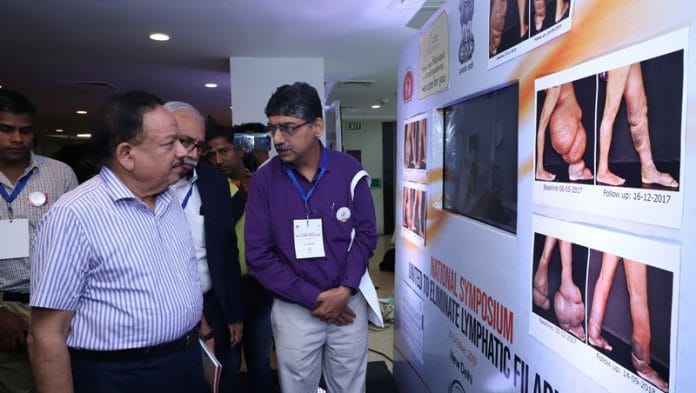New Delhi: India could miss its target of eliminating lymphatic filariasis, commonly known as haathi paon or elephantiasis, by 2021, due to poor awareness campaigns, an outdated surveillance mechanism and people’s aversion to taking preventive medicines.
If missed, this will be the third time in a row that the country will have failed to meet the elimination target for this infectious illness.
This is also likely to put the lives of 63 crore Indians across 257 districts at risk of contracting the disease.
A neglected tropical disease, lymphatic filariasis occurs when filarial parasitic worms — microfilaria — are transmitted to humans through infected mosquitoes found primarily in tropical regions. The disease, according to the World Health Organization (WHO), impairs the lymphatic system and can lead to abnormal enlargement of body parts, causing pain, severe disability and social stigma.
The National Program for Elimination of Lymphatic Filariasis (NPELF) was started by the UPA government in 2004. Since then, India has missed two elimination targets — one in 2015 and another in 2017.
Government officials and state coordinators of the WHO ThePrint spoke to said meeting the 2021 target was difficult.
“Going by current trends, India will not be able to eliminate the disease sooner than 2029,” said a state coordinator for National Tropical Disease (NTD), WHO.
“The calculation is simple,” he said, explaining that a drive to administer preventive medicine — called Mass Drug Administration (MDA) — takes three to five years.
Alongside MDA, a Transmission Assistance Survey (TSA) — which is done in every district to check the remaining existence of a disease — is also done three times after every two years.
If more than one per cent people in a district test positive for microfilaria, it is considered an endemic zone. “If any district clears this cut off, it is declared a non-endemic, free zone,” he added.
ThePrint also reached Nupur Roy, additional director at the Ministry of Health and Family Welfare, for a comment on the issue but she didn’t respond to text messages and calls till the time of publishing this report.
Also read: Our Covid vaccine could be important part of India’s early response, pharma giant Pfizer says
‘Campaign needs to be promoted by PM Modi or celebrities’
Dr N.K. Ganguly, an expert in vector borne diseases and a former director general at the Indian Council of Medical Research, also said the target of 2021 was difficult to achieve.
“We are unable to eliminate the disease primarily due to the lack of compliance to drugs. While the health staff distributes medicine to over 80 per cent of a district’s population, on an average, but eventually, not everyone ends up consuming the pills despite requests,” he told ThePrint.
“India needs a huge mass campaign, such as for polio or the Swachh Bharat Abhiyan where the message comes directly from the mouth of Prime Minister Narendra Modi or a powerful brand endorser,” he added.
Dr Devendra Singh Tomar, state NTD coordinator for WHO in Jharkhand, also agreed that “resistance from the population for not taking medicines needs a heavy mass-campaigning and local influencers in order to eliminate the disease”.
Several other state officers also told ThePrint that present data on endemic districts doesn’t include the new districts.
“We are using old data which doesn’t define the endemicity of a particular area. There are many other districts which report patients suffering from filariasis but the area is not counted under endemic districts. We need to remap the districts again using scientific and mathematical approaches to find the new districts,” said another state NTD coordinator.
There has also been a dearth of sufficient funds to pursue the mission aggressively, experts pointed.
“The government had shown commitment by launching accelerated plan for elimination strategy but the same needs to be reflected by allocating the adequate budget for each district, as the existing budget of Rs 5 lakh per district is not sufficient to conduct public awareness, training, social mobilisation and making arrangement for house-to-house drug delivery for entire population, with an 85 per cent coverage,” said Dr N.S. Dharmshaktu, former principal advisor, public health, at the health ministry, who is also known for his work in combating leprosy.
He added, “The good part is that provision of drugs and logistics of testing has been made to provide free service. But to ensure access to medicine for every one and convincing people to take medicines have been major challenges.”
Also read: To boost pharma investments, Modi govt sets up panel to revamp policies & draw up action plan
Status of disease burden in India
The National Vector Borne Disease Control Programme, under the health ministry, runs the elimination programme for lymphatic filariasis along with the WHO, the Gates Foundation and other NGOs that provide annual doses of anti-filarial drugs.
While the two-drug campaign of diethylcarbamazine and albendazole requires a minimum of five years to interrupt transmission of the disease, a triple drug therapy — adding drug Ivermectin to the two other drugs — was introduced in 19 districts across the country in March to accelerate the process of elimination by two-three years.
According to the Accelerated Plan for Elimination of Lymphatic Filariasis, launched by the health ministry in 2018, an annual single dose MDA programme was introduced in 202 of the 256 endemic districts in 2004, when the NPELF was launched.
Progress in eliminating the disease has, however, been slow. By 2007, the MDA programme was scaled up to cover all 256 districts. But since then, MDA has been completed and transmission interruption accomplished in only 94 districts. As of 2018, another group of 25 districts was being validated for interruption of transmission.
A new district was included as an endemic district in 2019, bringing the total number of endemic districts up to 257.
Also read: Less lipstick, more eyeliner — how Covid has changed India’s makeup market






